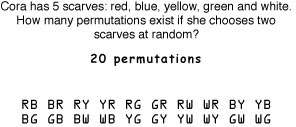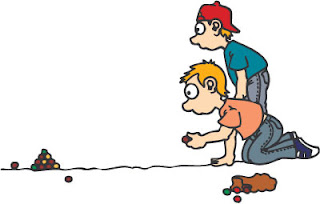Let's see if we can clarify the difference:
- Combinations involve making choices from multiple options (so do permutations)
- Combinations don't care in what order the selections are made (permutations do care)
- Combinations could include things like scoops of ice cream on a cone (any order is ok)
- Permutations exist when cones and scoops are chosen (cone is chosen first or sticky hands...)

Now I'm not sure that's a good example! If you are selecting ice cream scoops you don't normally have to worry about their order, or if they are co-mingled by melting. Let me try another one.
If you are selecting numbers and letters for a password, you can select them in any order but you have to be able to re-enter them in the SAME order or the password won't work.
This is an "ordered combination" of letters and numbers. A permutation.
Sometimes a password must begin or end with a number, and no repeating (33333) or sequential (12345) combinations are allowed. For security reasons, the software might also exclude your name, or your birthdate, because they are too easily guessed by a person who wants to hack into your information. These are permutations limited by externally-imposed rules.
There are lots of formulas and strategies for calculating combinations and permutations. Most of them exceed the limits of elementary math. We want to play with the concept, understand the distinctions, and happily getting the answer is key, not extrapolating general rules from a single example.
In Excel Math, most of the work is done by simply listing the possibilities, like this:

We start with the question and select the first letter of each color R, B, Y, G, W. If you have brown and black and blue you need another key letter, but any letter will do. Then we put the letters together in a string like this:

Remember that order matters when you are counting permutations. So Red-Yellow is NOT the same as Yellow-Red. If we didn't care about order we would have asked how many combinations we could make.
I like to line up my pairs in columns so I can make sure I get all the choices and no duplicates. Yes, there are formulas for calculating the answer, but getting the answer is key in today's blog, not extrapolating general rules from a single example ... by the way, if ice cream isn't your thing, and scarves are unnecessary in your climate, you can use marbles for your permutations.


No comments:
Post a Comment
Type your comment here